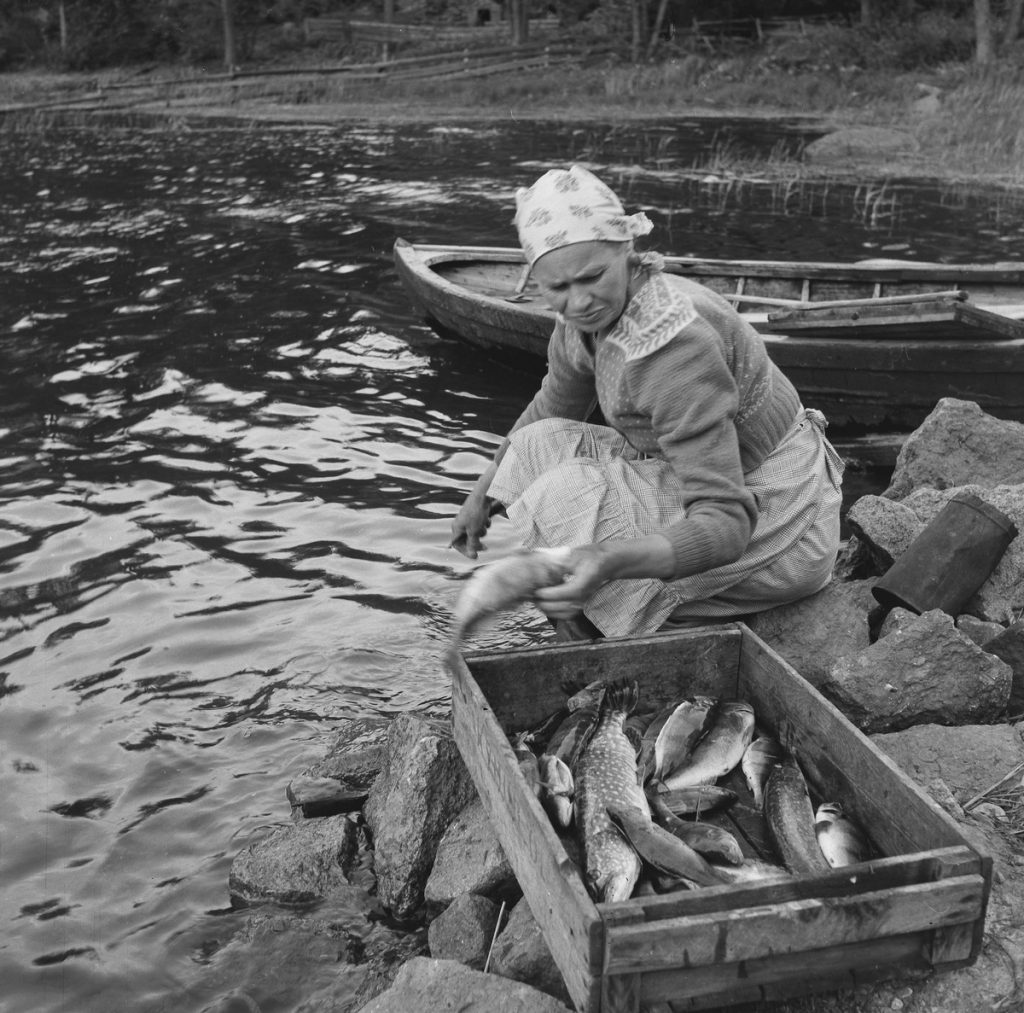Author: Matti Hannikainen
Fishing remains the most ancient method for gathering food that is still commercially important both locally and globally (Fagan 2018). Recent studies however suggest that by the 2030s, most commercial fisheries will be depleted beyond commercial use. Concerning sustainable food production, and the consumption of fish in particular, fisheries in Finland provides potential, which needs to be taken into account. In fact, recent discussions on food security and sustainability have highlighted the role of less valuable fish species. Yet the potential of less valuable species, such as roach (Rutilus rutilus), as a food reserve was recognised in the early 1950s as part of revising the scientific discourse on fish. Nonetheless, their history remains overlooked, which was the reason for analysing changes concerning the value and the consumption of various fish species in Finnish society during the 20th century.
An all-consuming society?
Recent research that has analysed the cultural value of fish in modernising Finnish society between the 1880s and 2010s, shows that the relationship between Finnish people and fish has changed drastically during the last century. The idea of inedible fish was alien in Finnish society in the late nineteenth century, because the evidence suggests that almost all fish, that were caught, were eaten in most cases salted or otherwise cured. Admittedly, some fish species have been valued for their taste and nutrient richness, whereas some have been disliked, because of their peculiar appearance or characteristic, above all, odour or taste. For instance, numerous cookbooks appreciate the taste of the fourhorn sculpin (Myoxocephalus quadricornis), especially in fish broth. Yet many Finns disapprove its peculiar looks. For example, according to an article published in 1925, most townspeople, ladies and servants in particular, ‘abhor this strange looking horned fish’, even though it was ‘a tasty fish cooked with ordinary spices.’ In fact, its large liver and roe were very valuable. The article ended underlining the importance of appearance ‘(t)he low status of the fourhorn sculpin is largely due to our ignorance about how to cook it’ (Suomen Kalastuslehti 1925, 48). As the society prospered and urbanised, Finns began to prefer certain species, such as Atlantic salmon (Salmo salar), trout (Salmo trutta) and whitefish (Coregonus lavaretus), whose stocks were often supported by aquaculture. This contradicts the assumption that modernity has increased the diversity of the catch and the consumption of fish. In contrast, Finnish consumption and the catch became more selective as the demand for many previously consumed fish species dwindled.

Classifying species for profit
Scientific discourse that was initiated during the 1890s classified fish species according to their commercial value. The discourse aimed at modernising the prevailing subsistence fishing into a commercially viable industry for fishers in particular. Thus, the scientific discourse on fishing attempted to concentrate fishing and the consumption of fish on the most commercially valuable species only. The new three-tier classification of fish into commercially valuable, less valuable and worthless fish species was introduced and disseminated via the new textbooks on fish and fishing in the early 1900s. While in the late nineteenth century textbooks on Finnish fauna had indicated that almost every species of fish caught was edible, the following textbooks, manuals and journal articles divided species according to their commercial value classifying numerous species worthless. There were only a few species however that were ranked as trash fish throughout the twentieth century: three-spiked spicklenecks (Gasterosteus aculeatus), silver bream (Blicca bjoerkna) and blue bream (Ballerus ballerus). Their “worthlessness” was based on their small size and hence, the lack of commercial value, and on the fact that they were perceived to compete over food with or by eating the roe of the more valuable species.
‘All begins from the plate’
Paradoxically, the concept trash fish surfaced in the culinary discourse when it disappeared from scientific discourse. In most historical studies fish has been taken for granted without considering changes in their cultural and commercial values not to mention changes in consumption (Räsänen 2021; Svanberg & Locker 2020; Greenberg 2010). The culinary discourse was thus crucial for analysing the consumption of and demand for fish in Finnish society. Most of the first Finnish cookbooks published in the 1890s were aimed at lower class women indicating a transition from oral tradition to written instructions in cooking. Reflecting the low-income level of their intended readers, most early cookbooks had more recipes for less valuable, cheaper fish species including roach than for expensive feast species, such as Atlantic salmon. In addition, most cookbooks provided recipes for salted fish that remained an important part of Finnish diet (Hannikainen 2022). Gradually, more recipes were published for fresh fish instead of cured fish reflecting the increasing demand for fresh fish.

The 1950s was the watershed in Finnish culinary history. Most importantly, Finns begun to prefer fresh fish in addition to which frozen imported fish and, later, farmed fish became preferred over salted fish marking one of the greatest changes in Finnish diet. Urbanising and modernising society moreover enjoyed the proliferation of electric kitchenware including stoves, refrigerators and freezers easing cooking. Sensory attributes for fish became more important in cookbooks that begun to emphasise taste, odour and structure of meat suggesting changes in valuing fish. The decline of the most commercially valuable species transformed the scientific discourse, because the only species that could withstand intensified fishing were those that had been classified less valuable and worthless i.e. trash fish. Accordingly, the prevailing three-tier classification (commercially valuable–less valuable–worthless) was changed into two-tier classification ranking all species to either commercially valuable or less valuable. The concept trash fish hence disappeared from the scientific discourse in the mid-1970s. Despite its strong, partly frightening rhetoric, exhorting the annihilation of worthless species, scientific discourse had had only minimal impact on the overall consumption of fish.
Paradoxically, the concept trash fish surfaced in the culinary discourse, when it disappeared from scientific discourse. Cookbooks hence divided fish species into two categories as part of the culinary discourse: commercially valuable and worthless species. Admittedly, trash fish was used by common people prior to the advent of the scientific discourse. There were 14 inscriptions from the period between 1890 and 1920 alone in the digitized newspapers and magazines of the National Archives suggesting that the concept was employed in the opinion letters and in fishing stories. However, most of the cases were located on the areas, where there were Atlantic salmon, trout and white fish spawned in central and northern Finland implying strong regional variations in the use of the concept (Hannikainen 2022). In addition, many cookbooks preferred more imported fish species than native Finnish species. Above all, trash fish were often omitted completely from cookbooks in contrast with the revised classification of the scientific discourse. There were however a few cookbooks published in the 1970s already that encouraged Finns to consume more those less valuable species that were labelled trash fish. While the stocks of most species popularised as trash fish has grown, their consumption seems to remain minimal – unfortunately.
New Hope?
While fish farming may provide employment, innovations in addition to imports, the key point is that the consumption of fish in addition to the way Finns value local fish species needs to change. Perhaps a historical analysis may provoke us to appreciate local species and to change our consumption of fish into more sustainable. Finland with its abundant ‘trash fish’ may remain self-sufficient concerning the consumption of fish. To reintroduce these sustainable fish species into Finnish diet, we may need more education, but above all co-operation with the ‘master chefs’ and leading restaurants. There are a few examples that may provide us with a useful starting point, such as FoodSmart DUBLIN. https://www.tcd.ie/tceh/projects/foodsmartdublin/research/
Sources
Fagan, Brian (2018). Fishing – How the Sea Fed Civilization. New Haven & London.
Paul Greenberg (2010). Four Fish – the future of the last wild food. New York.
Hannikainen, Matti O. (2022). “Roskaa vai ruokaa? Keittokirjojen kalat 1900-luvulla”, 196–235, in Jukka Mikkonen, Sanna Lehtinen, Kaisa Kortekallio & Noora-Helena Korpelainen (eds.) Ympäristömuutos ja estetiikka. Helsinki, https://helda.helsinki.fi/handle/10138/343564.
Räsänen, Tuomas (2021). Tyhjenevä maa – suhde luonnonvaraisiin eläimiin. in Ruuskanen, Esa, Paula Schönach, Kari Väyrynen, Matti Enbuske, Miina Kaarkoski, Ritva Kylli, Tanja Riekkinen, Tuomas Räsänen, Matti Salo & Jarno Valkonen. Suomen ympäristöhistoria 1700-luvulta nykyaikaan. Tampere: Vastapaino, 2021, 267–291.
Suomen kalastuslehti 1925.
Svanberg, Ingvar & Alison Locker (2020). Ethnoichthyology of freshwater fish in Europe: a review of vanishing traditional fisheries and their cultural significance in changing landscapes from the later medieval period with a focus on northern Europe. Journal of Ethnobiology and Ethnomedicine 16: 68,
DOI:10.1186/s13002-020-00410-3
Writer introduction
Dr Matti O. Hannikainen is a post-doctoral researcher in history at the University of Helsinki. He is also a member of Helsinki Institute for Sustainability Science.
